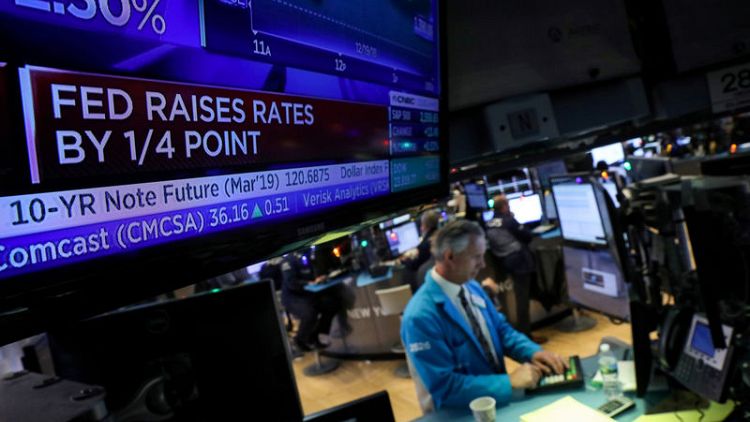By Howard Schneider
WASHINGTON (Reuters) - Late fall brought a dust cloud of bad news for the U.S. economy, with shippers like Fedex cutting their global outlook for next year, chipmaker Micron Technology missing its revenue target as demand slides worldwide, and GM trimming 14,000 jobs as sales slow, not to mention a stock market limping into year end.
To the policymakers at the U.S. Federal Reserve, however, that has so far added up to little more than noise and left Fed Chair Jerome Powell resolute as the lone major central banker tightening policy at a time when the world economy seems to be slipping and markets are moving against him.
It could make 2019 a difficult year for the Fed, and Powell seemed to acknowledge as much in a post-policy-meeting press conference on Wednesday as he tried to fit the square peg of a potentially weaker outlook into the round hole of stricter policy. Markets headed south as he spoke.
"The question is, is this Fed being too sanguine?...At least from the market's lens the answer is yes," with investors pricing different assets on the assumption that the Fed's recent rate increase and policy outlook is a "mistake," said Ed Al-Hussainy, senior rates analyst at Columbia Threadneedle Investments. In the Fed's policy statement and the language of Powell's press conference, by contrast, stock and bond market trading is "getting a pretty small amount of weight."
That's unlikely to change.
Stock markets on Thursday continued a selloff that has driven the S&P 500 down 15 percent since October, with investors reacting negatively to the outcome of this week's Fed meeting and their dashed hopes policymakers would declare interest rate hikes at an end. Federal funds futures show traders believe the Fed won't raise rates at all in 2019, even though policymakers currently see two rate increases as likely appropriate over the next 12 months.
But Powell has been consistent over his first year as chairman that even though he spent much of his career in and around financial markets, he would not respond to their daily whims.
President Donald Trump may be urging him to "feel the market" in setting policy, but Powell laid out his template for decisionmaking in a major policy address at Jackson Hole last August. It leaned heavily on managing risks around topline macroeconomic data like the unemployment rate, not how stocks are faring in a $20 trillion economy that would need more than the lost paper wealth of a few bad trading days to knock it off course.
In particular, his speech that day noted that, even if the longstanding connection between very low unemployment and high inflation seems to have been broken, it would be dangerous for a central banker to ignore the risk that it could reemerge, and force a recession-inducing run-up in interest rates.
"The market is so sharply focused on downside risks to the economy, but the Fed’s risk management approach can’t simply ignore that upside risks exist as well," analysts with NatWest Markets wrote on Thursday in the wake of the Fed's decision to raise rates for the seventh time in eight quarters to a range of between 2.25 and 2.5 percent.
That will feed through to a range of other rates, including home mortgages, and that will in turn dampen economic activity at the margins. But even with the Fed's latest rate increase, mortgage rates are low compared to historical averages, and financial conditions remain loose even if they have grown slightly less so in recent weeks.
Though the Fed did indicate it would raise rates more slowly than previously expected next year, the Fed's core conclusion remains intact: the economy is growing, joblessness is low, and the central bank's support is no longer needed. https://tmsnrt.rs/2Gzmern
Investors may hope for a Fed "put" to support nervous markets, but so far the central bank remains comfortable with even higher rates, and a steady, $50 billion monthly decline in its balance sheet.
It is a logical stance, said Vincent Reinhart, chief economist at Standish Mellon Asset Management and a former head of monetary affairs at the Fed.
"We will be printing an above 3 percent real gross domestic product growth for 2018 with an unemployment rate of 3.7 percent," Reinhart said. "The U.S. economy has momentum...This is not a group that is overly concerned about financial market volatility."
The more present danger, Reinhart said, is likely outside the United States. A slowdown in China could export lower prices worldwide, and keep the Fed from reaching one of its key goals of 2 percent inflation.
Other major central banks, meanwhile, are still anchored at zero interest rates, making every further step by the Fed that much riskier because it draws capital toward the United States, strengthens the dollar, and potentially weakens U.S. exports and growth.
Similar concerns slowed the Fed before, and may mean uncertain days ahead.
“We are in the heavy lifting phase of monetary policy," said Rinehart. "They have been pressured by events...The question is when do you stop?"
Graphic - The Fed's puzzle: https://tmsnrt.rs/2Gzmern
(Reporting by Howard Schneider; Editing by Andrea Ricci)



